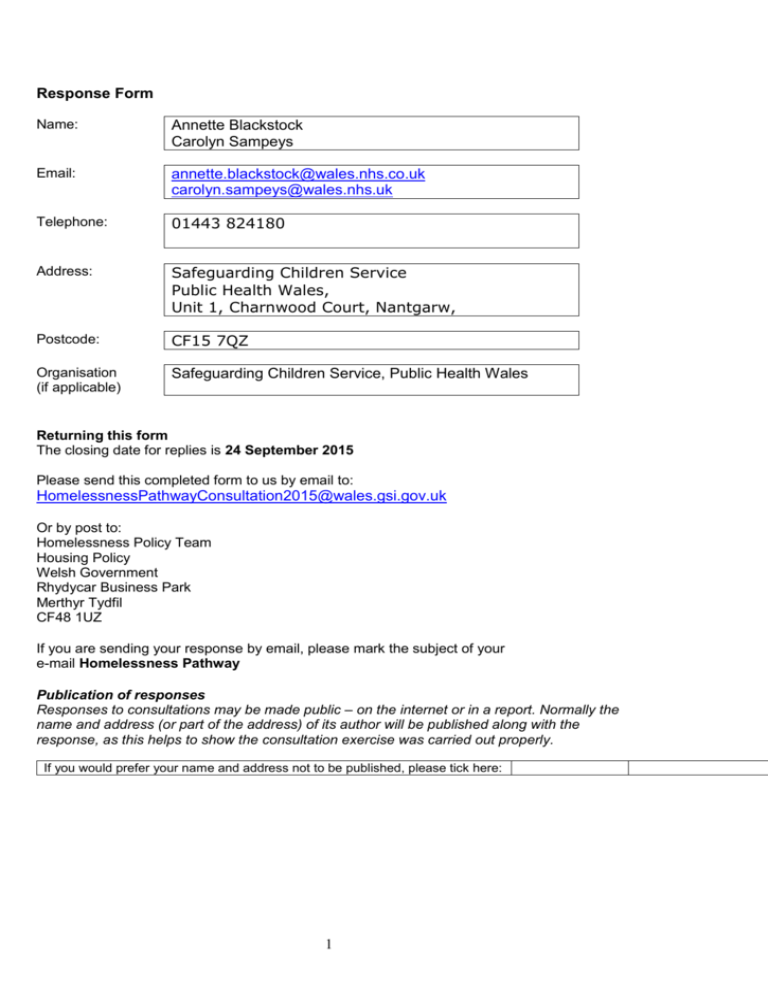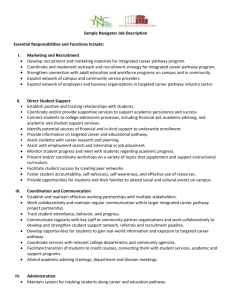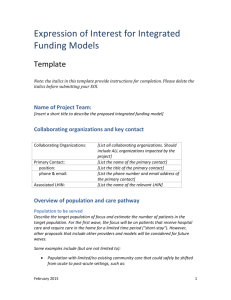National Pathway for Homelessness Services to Children
advertisement

Response Form Name: Annette Blackstock Carolyn Sampeys Email: annette.blackstock@wales.nhs.co.uk carolyn.sampeys@wales.nhs.uk Telephone: 01443 824180 Address: Safeguarding Children Service Public Health Wales, Unit 1, Charnwood Court, Nantgarw, Postcode: CF15 7QZ Organisation (if applicable) Safeguarding Children Service, Public Health Wales Returning this form The closing date for replies is 24 September 2015 Please send this completed form to us by email to: HomelessnessPathwayConsultation2015@wales.gsi.gov.uk Or by post to: Homelessness Policy Team Housing Policy Welsh Government Rhydycar Business Park Merthyr Tydfil CF48 1UZ If you are sending your response by email, please mark the subject of your e-mail Homelessness Pathway Publication of responses Responses to consultations may be made public – on the internet or in a report. Normally the name and address (or part of the address) of its author will be published along with the response, as this helps to show the consultation exercise was carried out properly. If you would prefer your name and address not to be published, please tick here: 1 1. Is the process outlined in the Pathway clear for you to establish who is responsible for each stage? Yes No x If not, why not? The process given and the diagram of the pathway given were clear. It seems that colour coding on the pathway is important when looking to define which agency is responsible at every stage. However, it may be more difficult for those who do not have the pathway in colour format. We suggest that the key may need to have another identifier such as agency initials. We also thought that the pathway may benefit by clarifying that the ‘Offender Manager’ has overall responsibility throughout for adults. In the case of young people and children, there may be different professionals with overall responsibility. 2. Does the process outlined in the Pathway adequately address the requirements of the Housing (Wales) Act 2014 and Offender Rehabilitation Act 2014? Yes x No If not, why not? The pathway appears to link well with the Housing Act and we felt that paragraph 45 of the notes demonstrates a reminder to consider the needs of the whole family and dependants of the offender. There appears to be a clear link and guidance to referring to the Local Authority Housing, to support any family of the offender. We agreed that it is positive that the pathway for Adults has consideration for a potential need for a Core Assessment (paragraph 46). The pathway can encompass a holistic family and child approach and / or adult vulnerability. Seeing the offender as potentially part of a family – and noting that there will be an effect on the wider family and perhaps children. 3. Does the Pathway adequately explain how organisations should work together to tackle homelessness for those due to leave the secure estate? Yes x No If not, why not? The pathway seems to allow an opportunity for timely discussion about the offender’s housing needs at key stages in the custody process. We are hopeful that the ‘initial assessment tools’ will allow discussion about any additional needs of an ‘adult at risk’ 2 and / or a child in the secure estate (see question 5 for further comments). 4. Do you feel the Pathway could be strengthened or made easier to use? If so, please explain. Yes x No If yes, how? We considered how the strength in the links between Local Authority Housing and Corporate Local Authority could be dependent upon each area, which may impact on the process overall. Potentially, the pathway creates opportunities to make early links using the initial assessment tools; agencies working together across adults, young people and children. Considering the needs of the pathway for a young person, we felt that it is not clear that YOT is involved throughout. 5. Are there any other comments you would like to make about the Pathway? Yes x No Overall, we felt that this is a positive and clear pathway. The following are comments that are from our discussions: On the pathway documentation we were not clear about what the ‘Basic Custody Screening Tool Part 1 or 2’. The attached form ‘section A’ onwards showed some assessment questions but we could not be sure that this was the same as ‘Tools 1 and 2’. The Personal Housing Plan form was useful. From a safeguarding viewpoint, we felt that early identification of Health, mental health, housing and family needs are crucial in order to link with relevant agencies that may be already supporting the individual or a family. Does the screening tool gather information about wider needs or concerns about validity of addresses given by an offender on release? The support for housing also would be considering the risk, needs and impact on local communities. There is a potential for risks to the family as well as the offender themselves. We felt it was positive that importance was given to considering giving additional support, links and education for female 3 offenders. Paragraph 78 looks at suitability of accommodation where primary carers are re-establishing connections with children on leaving custody. Multi agency links and connected working practice is key here to safeguard against risk to the child. Where children may be ‘looked after’ during custody, there may be care proceedings which are ongoing. Professionals overseeing resettlement will need to consider managing or thinking about any potential untoward contact with the children. There is a possibility that the parent may pose a risk to their children, as well as pose a risk to others. We felt it was very positive that there is contact and review every month during sentences with a young person or child regarding housing needs. This shows pre planning and a positive repetitive cycle in the pathway. Alongside this, the Core Assessment is visible in the pathway for Young people. Considering the needs of Young people, we thought about where there is a potential change of status from child to adult during the custody period. We surmised that YOT would remain responsible for a young person, using their multi disciplinary approach to offer the best support for the young person in transition to adult services. However, the pathway of choice may not be clear. Social Services and Well being Act set out the duties for Looked After Children (LAC): Paragraph 93 and 98 recognises these additional concerns and further for children ‘post’ LAC. Considering the needs of the adult at risk, we felt it was positive that there are opportunities in the pathway for third party referrals when there are concerns about or priority needs. 4







